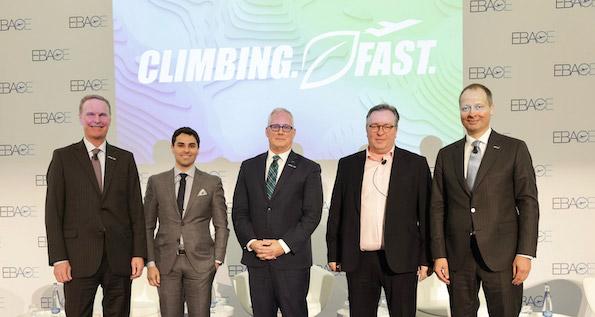European Business Aviation Association Adopts ‘Climbing. Fast.’ Campaign

Discussing business aviation sustainability technology and goals at EBACE were (from left): Ed Bolen, NBAA president and CEO; Kennedy Ricci, 4Air president; Kurt Edwards, International Business Aviation Council director general; Patrick Hansen, Luxaviation CEO; and Holger Krahmer, EBAA president.
GENEVA—The European Business Aviation Association has adopted the “Climbing. Fast.” campaign launched by the National Business Aviation Association Convention & Exhibition (NBAA-BACE) in October as a way to support and advance the industry’s commitment to net-zero carbon emissions by 2050.
The partnership was announced during the European Business Aviation Convention & Exhibition’s (EBACE) pre-convention media day in a Newsmaker Session called Bizav Leaders’ Perspectives on the Global Mission to Net Zero.
Climbing. Fast. is an initiative to educate policymakers and opinion leaders about business aviation’s benefits, including jobs and economic activity, connecting communities, aiding businesses, providing humanitarian services and other benefits. It also is at the forefront of aviation sustainability through innovation, on the ground and in the air, the European Business Aviation Association (EBAA) says.
“By championing Climbing. Fast. in Europe, EBAA will leverage its deep understanding of European policy and its extensive network to ensure that the initiative is effectively localized and implemented, enhancing its impact and relevance on this side of the Atlantic,” EBAA Secretary General Holger Krahmer said.
The business aviation industry is united in its work to build on its record of cutting carbon emissions by 40% in four decades, Krahmer said.
The industry is working to increase the production and availability of sustainable aviation fuel (SAF), which can reduce aviation life-cycle greenhouse gas emissions by as much as 80%, according to the association. At the same time, aircraft that use hybrid, electric and hydrogen propulsion systems are nearing certification.
“Business aviation has a unique opportunity but also a clear track record of being leaders on efficiency,” said Ed Bolen, NBAA president and CEO. “We’ve brought forward everything from winglets, composite technologies, early adoption of GPS, so there’s a lot of effort within our community to constantly promote new technologies, new awareness, new operations. But it’s clear we’re also operating in a heavily regulated industry in the United States and around the world.”
Climbing. Fast. “is about helping us as a community get on the same page and tell the story,” Bolen noted. “There are different companies doing different things. There are different countries and regions of the world who need different messaging for where they are, but globally Climbing. Fast. is what our industry is doing.”
The European Union has set itself an ambitious climate agenda, Krahmer said. “I think what the European regulator and European Commission simply underestimates and didn’t consider enough is the business impact and the business needs to achieve these targets,” he asserted. “That’s not only for business aviation; that’s for the whole industry. Unfortunately, we are surrounded by politicians [who] simply underestimate or even ignore the innovative potential that business aviation has.”
They must go to the politicians to inform them of business aviation’s advantages and that business aviation is a leader, Krahmer said. “But to be honest, this is challenging,” he acknowledged. “As we see challenging times for business aviation in Europe, as we see politicians, political stakeholders—they have the agenda to ground business aviation.”
The industry must take pride in being part of the solution to the goal to reduce emissions and its work to push sustainable aviation fuel, said Patrick Hansen, Luxaviation CEO. “But it’s not sustainable aviation fuel—that’s one of the various initiatives. If we think about 2050, I would hope that sooner or later electrification of aviation will happen and hydrogen will be used. We see our industry as the leader in that.”
The industry recognizes that SAF is at the foundation of how it might achieve net-zero carbon emissions by 2050, the NBAA’s Bolen said. “The good news is that we are seeing more and more pathways to SAF,” he noted. “More and more companies are investing. More and more refineries are coming online. But we still have a problem, particularly for the business aviation community where we operate out of a lot of fields everywhere, and SAF is produced in a location. So there’s the challenge of transporting SAF.”
One of the initiatives the industry has looked into is the ability to use a book-and-claim system, in which a buyer pays for SAF and claims the credits, but another party actually uses the fuel.
4Air, which offers carbon offset programs, has been studying nitrous oxides and contrails, its president, Kennedy Ricci, said. “We care about whether the contrail forms, and we care about whether or not the contrail persists.”
For business aviation, there is an opportunity to fly above contrail regions. 4Air’s study looked at nearly 17,000 flights over the course of a year and examined the patterns of contrail creation, their persistence and how to mitigate them, Ricci reported. “The great news is that business aviation has a very unique opportunity here, and as we develop tools with this, we can help bring that to commercial aviation as well.”





